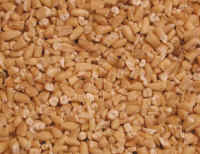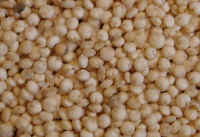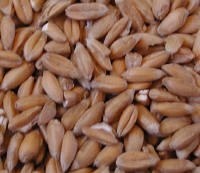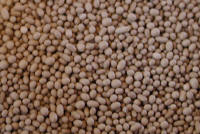 Grains
and Bread Making Ingredients - Ingredients Descriptions and Photos
Grains
and Bread Making Ingredients - Ingredients Descriptions and Photos
From All-Creatures.org Vegan - Vegetarian Recipe Book: How Mary and Frank and Friends Eat
"We are dedicated to cruelty-free living through a vegetarian - vegan lifestyle. Let no animal suffer or die that we may live!"
Ingredients Descriptions and Photos
Grains and Bread Making Ingredients
Table of Contents




Corn Grits (see Polents)




























 (Yeast)
Yeast are single-celled plants. They are fungus that ferment starches and
sugars. One of the by-products of this fermentation process is carbon
dioxide gas which forms little bubbles in bread dough and causes it to rise.
These fungus plants are killed during baking. We purchase our yeast in
bulk (1 or 2 pound packages) and store in tightly sealed glass jars in our
refrigerator . We have found two forms of commercial yeast: the one
pictured above left is an enlargement of the "bead" or granular form of dried
yeast clusters, and the other, (Yeast 2), pictured
right in an enlargement, is the extruded form of commercial yeast. Note
that the "cylinders" of yeast have become polarized, and that the static
electricity and magnetic field causes them to stick together end to end.
As far as performance in baking, there is no difference in various forms of yeast.
(Yeast)
Yeast are single-celled plants. They are fungus that ferment starches and
sugars. One of the by-products of this fermentation process is carbon
dioxide gas which forms little bubbles in bread dough and causes it to rise.
These fungus plants are killed during baking. We purchase our yeast in
bulk (1 or 2 pound packages) and store in tightly sealed glass jars in our
refrigerator . We have found two forms of commercial yeast: the one
pictured above left is an enlargement of the "bead" or granular form of dried
yeast clusters, and the other, (Yeast 2), pictured
right in an enlargement, is the extruded form of commercial yeast. Note
that the "cylinders" of yeast have become polarized, and that the static
electricity and magnetic field causes them to stick together end to end.
As far as performance in baking, there is no difference in various forms of yeast.
Return to: Ingredients Description and Photos
 The
above recipe is in keeping with God's creation intent (Genesis 1:29-31):
'Then God said, "I give you every seed-bearing plant on the face of the whole earth and every
tree that has fruit with seed in it. They will be yours for food. And to all the beasts of the
earth and all the birds of the air and all the creatures that move on the ground-- everything that
has the breath of life in it-- I give every green plant for food." And it was so. God saw all
that he had made, and it was very good.' (NIV) Let no animal suffer or die that we may live!
The
above recipe is in keeping with God's creation intent (Genesis 1:29-31):
'Then God said, "I give you every seed-bearing plant on the face of the whole earth and every
tree that has fruit with seed in it. They will be yours for food. And to all the beasts of the
earth and all the birds of the air and all the creatures that move on the ground-- everything that
has the breath of life in it-- I give every green plant for food." And it was so. God saw all
that he had made, and it was very good.' (NIV) Let no animal suffer or die that we may live!






